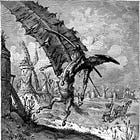Start Narrow, Grow Wide
Part I: The Counterintuitive Shape of Trader Development
Dear Practitioners,
Happy October!
Start Narrow, Grow Wide is the first part of a new Feature examining the strange and difficult process of trader development. It formalises and ties together nodes from the ‘Idea Index’—especially The Minimum Viable Trader—while introducing new reflections from the floor and other Asymmetrist material. This instalment lays the groundwork, shaped by observations at the AXIA desks, reflections from early trader careers in Traders of Our Time, and a passionate ‘letter to the editor’.
As ever, I’m experimenting with release cadence, length, and depth. Here I’m opting for more frequent, shorter parts to give you space to digest before the next instalment. I’m always happy to receive your thoughts, which may influence or deepen what follows. Comment below, or email me at bogdan@asymmetrist.com.

Part I: Essence
“The problem is that new traders aren’t isolated enough!” This is true, and perversely so: weaknesses often launch a trader’s career as much as strengths can end one. Many are lost in the transition because launching is different and often antagonistic to sustaining a career. In concluding this letter to the editor, R.G.—a trader on AXIA’s Cyprus floor, who we met in Vertical Learning—was reacting against ’Tis But A Pullback. Specifically against the case made for novice traders to “work to expand your opportunity set.”
Expanding opportunity sets protects against the dangers of success, which reinforces the trader’s propensity to optimise, even myopically ‘solving’ the current market environment through iterations of doing the same thing. This renders the trader brittle in the face of inevitable change. The longer the environment remains stable, the more resistant the trader becomes to change, due to further optimisation leading to more reward. Inexperience, ostensibly a weakness, can be a strength because the novice is not wedded to an outdated environment. Fresh eyes launch the career, but cannot sustain it!
For R.G., isolation means focus. Many novice traders default to consuming novel information and learning opportunities on the trading floor and online. All good learners venture widely, but this strength can be insidiously detrimental. String out this process enough and “you get pulled in all directions,” R.G. continues, “so many fail to get running in the first place … they fall into the trap of looking at everything … when a new trader starts, the best advice is to hone in and become good at it. Once you have the P&L you can reinvest it into other areas.” This doesn’t justify knee-jerk advice online—stick to one market! Stick to X, that worked for me!—which is mere regurgitation of misapplied or a outdated meta-game. Rather, it is a focus on present opportunities crossed with the novice witnessing and believing others on their team, community or trading floor executing these opportunities.
Both contradictions, expand and focus, coexist yet are managed through the perpetually scarce resources of context and nuance. Those who attempt the reverse—start wide—never monetise before their unsustainable career ends. There’s a gulf of adjacent skills, exposure, and experiences that take years to accrue—‘going wide’—making it unjustifiable for a trader to not monetise something in that time. Those who start narrow yet remain narrow find their skills redundant. Those who start narrow then grow wide navigate this contradiction. It’s the pattern of many early trading careers—intentional or not—which has led to long careers. Over time, the market has filtered out anything else.
To understand why to start narrow is to propose the ‘minimum viable trader’—MVT. This trader exists in a scrappy, do-or-die, siege mentality more visible in the start-up world. At this stage, the trader is a start-up with limited runway: time, funds, faith. Inexperience and constraints are ostensibly weaknesses that launch careers because they result in focus—hence R.G.’s argument—and inexperience brings fresh eyes. Constraints come in many forms: little risk allocated to the novice on the day or fixed to trade one lot, so they cannot manage size dynamically and must resort to static sizing: ‘all-in, all-out’. Yet, this can stimulate creativity and permit the novice to derive insights. Some trade execution ‘styles’ have been birthed seemingly ex nihilo because of the novice finding novel ways to execute around their constraints.
Other times, constraints can be enforced from above: you can only trade headlines. This mostly eliminates the ‘fuzzy engagement’ problem: trading an opportunity that is just good enough, without the market pressuring the trader to exit. The novice suffers from the worst of this, because everything looks like an opportunity, which cannot be true at their stage. A constraint, such as limiting them to only trading headlines, prevents them from being embroiled in the markets, since this is one of the few situations where permissiveness of action is nearly binary. For a novice under this constraint, their commitment to trading only thin slivers of time and place—that could be called ‘edge’—is far clearer than it would be with no constraint at all.
The MVT aims to launch fast, monetise the current environment, and pivot when change comes. This increases survival chances due to their now extended runway: some funds, some validation, some faith. Extra time is now afforded for innovation and mutation. At some point, the scrappy minimum viable trader must leave the besieged fortress and embark on a long, open-ended journey to expand and outgrow the market’s mercies. They must evolve into the ‘always viable trader’—the AVT, who can virtually monetise most environments, to varying degrees of success. Essentially, the AVT can respond to anything, but excels during regime transitions, when volatility and opportunities peak. This is what The Student in Traders of Our Time calls the “all-seasons” trader, a direction he has been successfully working towards for over five years. His results and skillset reflect that trajectory: monetising the market profile and news headlines, and deploying trades across various products and asset classes. It means dissolving method, identity, and strategy once they are no longer required.
We’ll explore a third area: those breaking out of the MVT, who just ended the siege and are starting the AVT journey. The trading ‘journey’. Arguably, this is R.G.’s situation and a few young AXIA traders who made their bones in the past year. This transition helps us review the essence of the problem: the markets can only be navigated, not solved. Yet, the MVT solution for new, unprofitable traders requires them to ‘solve’ the current market state quickly and minimally. Once their account and career are off the ground, these former MVTs have to become true navigators: enhance their perceptual learning and codify it into actual knowledge and durable understanding. To now think and grow widely, after being used to profiting narrowly. To then deal with certain traps, like the ‘hidden curriculum’ problem, and beyond. We’ll return to these later, drawing on trader careers as examples.
The trader’s persona, which includes the mindset, habits, practices, and beliefs, must change from MVT to AVT. The context for receiving suggestions or directives must also change, from staying focused to expanding opportunity sets. Hence R.G.’s reaction and Asymmetrist’s case of expanding opportunity sets are valid depending on time and place. Neither the minimum-viable nor the always-viable trader is a fixed state, like a light switch. Instead, they are a rough grouping of phenomena observed in traders over time. This changes over the years. We will not exhaust these observations here, and the AVT is a guiding principle and never ‘achievable’, unlike the MVT which is a period in a trader’s career to overcome. Grasp the general intention of these labels, and you’re already more than halfway there. It’s often about making the implicit, explicit.
»Part II Is Out!
Acknowledgements, Permissions & Disclaimer
Grateful acknowledgment to AXIA for granting access to their London trading floor and to observe and learn as “writer-in-residence.”
The photograph, provided by Axia Futures, is used with their permission, and they retain full ownership and copyright over the image.
Disclaimer: Do Not Do Stupid Financial Decisions. This Is Not A Game.



